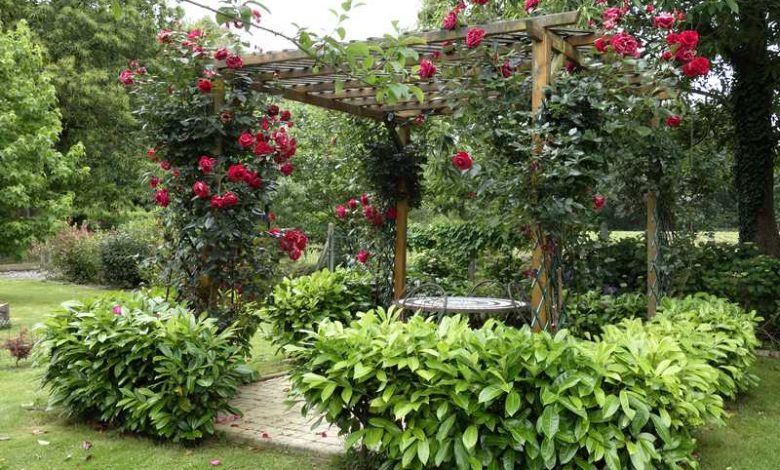
Inherited from romantic gardens, but timeless, the pergola is the preferred support for climbing plants. It also makes it possible to create a place in the pleasant shade to read, for a dining area, or to relax.
The pergola, open to the outside!
The pergola is, by definition, a skeleton construction: that is to say neither completely open nor completely closed. When it is positioned on the terrace, it offers a soft transition space between the house and the garden.
Generally made from wooden posts and beams, this type of structure is increasingly found in aluminium. A light material, more robust over time than wood, and almost maintenance-free.
In some old gardens, one also marvels at a pergola with uprights and crosspieces in stone decorated with motifs from Antiquity: Corinthian columns for example with sculpted elements. We then speak of “factory” to designate them. These hard pergolas were very fashionable in the 19th century in large romantic gardens that were landscaped in the English style. It is possible to hunt for them: perhaps you will then be lucky enough to come across real rare pearls…
The pergola should be thought of as a living space
In the South and the Mediterranean regions, the pergola is rightly considered as an additional living room. It is generally leaned against a wall of the house to shade a terrace overwhelmed with heat.
In regions with a less clement climate, it offers a protected space, half-covered, half-closed, in which it is pleasant to settle down to read or chat while enjoying the fresh air.
A structure covered with climbing plants
The pergola also offers an elegant structure for climbers, allowing you to create a flowery, colorful terrace and enjoy their intoxicating scents.
But not all climbing plants are suitable. For example, avoid covering the structure with wisteria and bignone, two vigorous vines whose powerful branches can bend or even break the uprights and crosspieces.
Also avoid fruit vines such as vines or kiwis, which attract hornets when the fruits reach maturity.
Here are some climbing ideas that will pleasantly cover the pillars of your pergola without damaging them:
- The star jasmine (Trachelospermum jasminoides) is adorned with beautiful starry white flowers in early summer resembling those of jasmine, with twisted petals. Deliciously fragrant, it remains very decorative all year round with its shiny and evergreen foliage. Its growth is slow, its maintenance limited.
- The association climbing rose and summer clematis offers a superb spectacle. For example, try the refined marriage of the deep purple of the Lasurstern clematis (Clematis Lasurstern) and the pure white of the Climbing Iceberg rose.
- The Hall’s prolific honeysuckle offers, as its name suggests, a profusion of small creamy white flowers, then yellow, very fragrant, without interruption throughout the summer. Install it on an upright in the sun or in partial shade. Its growth is rapid. It can reach between 4 and 6 m!

At the end of the season, clean these climbing plants. Also regularly prune branches that are too long to balance the silhouette.
But wait until the end of winter to carry out more important maintenance pruning: removal of dead wood and one out of two branches at the base so that the honeysuckle grows.
Maintenance of an aluminum pergola
An aluminum pergola retains its original appearance for many, many years. Its maintenance is limited to an annual cleaning of the structure (or every two years). Do it by hand, scrubbing the uprights with a soft-bristled brush and soapy water or a low-pressure cleaner.
Also check the good solidity of the seals and screws every year.
Maintenance of a wooden pergola
If the pergola is made of treated wood , its maintenance is a little more restrictive. It is indeed necessary to apply one or two coats of colorless stain every 3 to 5 years to reinforce the protection of the wood against external aggressions.
Avoid colored paints: they flake off after 4 or 5 years, which is not really aesthetic.
For renovation and maintenance in the rules of the art, it is not necessary to dismantle the structure. On the other hand, all the uprights and crosspieces must be carefully cleaned and sanded, then completely repainted to waterproof the wood while letting it breathe.
